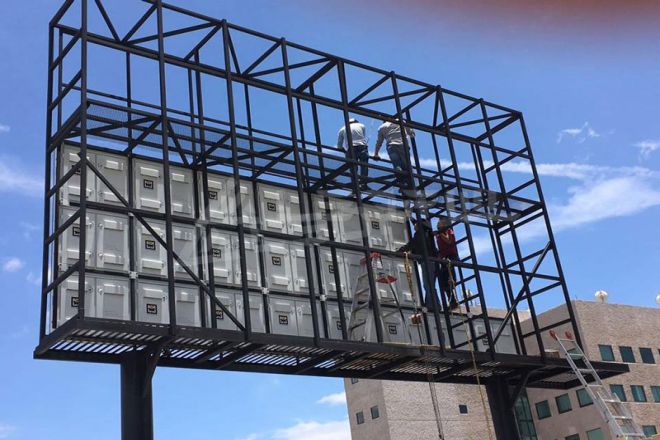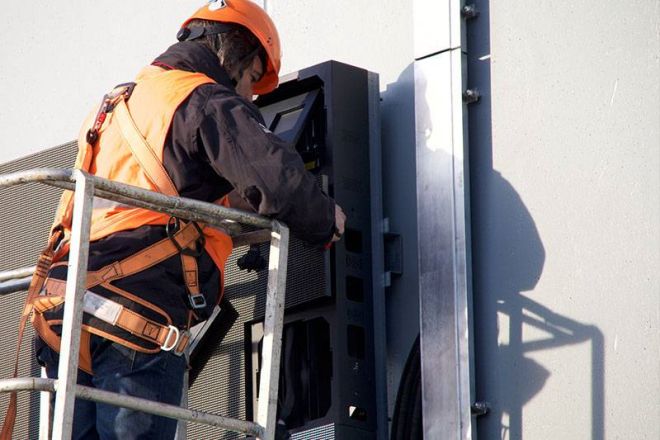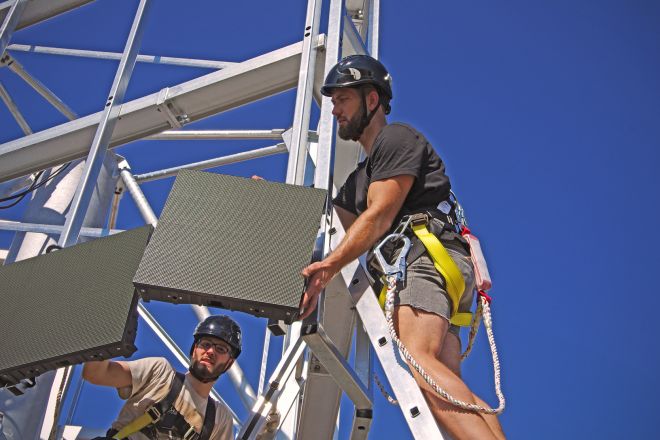Introduction

With the continuous development of LED display technology, outdoor LED display is increasingly widely used in advertising, information dissemination, event display, and other fields.
However, the complexity and unpredictability of the outdoor environment make the installation of LED displays challenging. This article will discuss the many aspects that need to be paid attention to when installing outdoor LED display screens to ensure the safety, efficiency, and stability of the installation process.
1. Preparation before installation
1). Site survey
Before installing the outdoor LED display, a detailed survey of the installation site is necessary. This step is crucial because it directly affects the stability and use effect of the display.
Understand the topography, climate, wind, and other natural conditions of the installation site
Terrain survey: Understand whether the installation site is flat, whether there is a slope, and whether there is unevenness. These terrain characteristics will directly affect the fixed mode of the display screen and the choice of bracket structure.
Climate assessment: Examine the local climate characteristics, including temperature, humidity, rainfall, etc. This information helps to choose the display material and waterproof and dustproof level suitable for the outdoor environment.
Wind assessment: evaluate the wind situation at the installation site, especially the impact of strong winds, hurricanes, and other extreme weather conditions. This will help determine whether the fixed structure of the display can withstand the impact of the wind.
2). Check whether the site has a stable power supply and reasonable installation space
Power check: Ensure that the installation site has a stable power supply that can meet the power needs of the display screen. In addition, the safety of the power line should also be considered to avoid potential safety hazards caused by power problems.
Space evaluation: Check whether the site has enough space to install the display screen and related equipment, such as brackets, cables, etc. At the same time, it is necessary to take into account the heat dissipation needs of the display screen and ensure that there is enough ventilation space around it.
3). Equipment selection
Select the appropriate LED display model and specifications according to actual needs
Requirements analysis: Determine the size, resolution, brightness, and other parameters of the display according to the use scenario and requirements. For example, in advertising, you may need to choose a high-brightness, high-definition display screen to attract attention; in a stadium, you may need to choose a large display screen with a high refresh rate to meet the viewing needs of the audience.
Model comparison: Compare different brands and models of display screens in the market and choose products with stable performance and reasonable prices. At the same time, we should pay attention to the display effect, service life, and after-sales service of the display screen.
4). Consider the brightness, resolution, waterproof and dustproof level, and other performance indicators of the display screen.
Brightness selection: Select the appropriate brightness according to the lighting conditions and viewing distance of the installation site. In a sunny environment, you need to choose a high-brightness display to ensure the display effect.
Resolution evaluation: The higher the resolution, the clearer the display effect. Choose the appropriate resolution according to the actual needs to meet the visual needs of the viewer.
Waterproof and dustproof level: According to the local climatic conditions and installation environment, choose a display screen with a high waterproof and dustproof level. This will help ensure the normal operation of the display in harsh environments and extend its service life.
5). Develop an installation plan
Develop a detailed installation plan according to the site conditions and equipment performance
In the process of formulating the installation plan, it is necessary to comprehensively consider the site conditions, equipment performance, and actual use requirements. This includes determining the installation position, fixing mode, cable layout, and other key elements.
Installation location selection: Determine the best installation location for the display screen according to the site survey results and actual needs. The viewing angle and distance of the audience and the coordination between the display screen and the surrounding environment should be taken into account.
Determine the fixing method: choose the appropriate fixing method and bracket structure according to the terrain conditions and the size and weight of the display screen. Ensure that the display can be firmly installed on the bracket and resist the influence of natural factors such as wind.
Cable layout planning: reasonably plan the layout and trend of the cable to avoid potential safety hazards and signal attenuation caused by excessively long or messy cables. At the same time, the waterproof performance of the cable should be considered to meet the needs of the outdoor environment.
Formulating a detailed installation plan will help to improve the installation efficiency and quality to ensure the stable operation and long-term use effect of the display.
2. Precautions during installation

- Safety protection
Safety protection is the primary consideration when installing outdoor LED displays. First of all, all construction personnel must strictly abide by the safety operation procedures and must not be sloppy or careless because any small mistake can lead to serious consequences and even threaten the personal safety of construction personnel.
Secondly, construction personnel should be equipped with necessary safety protection equipment, such as safety helmets, seat belts, non-slip shoes, etc. This equipment can effectively protect the safety of construction personnel when working at high altitudes or when touching sharp objects.
At the same time, it is also necessary to ensure that all construction personnel have received relevant safety training on how to use these protective equipment correctly.
- Accurate measurement and positioning
In order to ensure the accuracy and stability of the display installation, accurate measurement tools must be used for positioning and measurement.
This includes accurate measurement of the installation position, a detailed understanding of the size and structure of the bracket or building, etc. Only by ensuring the accuracy of these data can we ensure that the display screen will not be tilted or distorted after installation.
Pay special attention to details when adjusting the horizontal and verticality of the display. Any slight deviation may lead to a poor display of the display.
Therefore, it is necessary to use professional horizontal and vertical instruments to make accurate adjustments to ensure that the display screen can remain flat and stable after installation.
- Stable and fixed
Choosing the right fixing method and material is the key to ensuring that the display is firmly fixed. When choosing the fixed method, it should be comprehensively considered according to the size and weight of the display and the environmental conditions of the installation location.
For example, in areas with strong winds, it is necessary to choose a more stable fixing method, such as welding or bolting.
At the same time, the degree of fastening of the fixtures should be checked regularly to prevent safety accidents caused by loosening. Especially after severe weather, such as strong winds and rainstorms, it is necessary to check the fastening of the fixtures in time to ensure the safety and stability of the display screen.
- Cable wiring
Cable wiring is a part that cannot be ignored during the installation process. Reasonable planning of cable wiring can avoid safety hazards and signal attenuation caused by excessively long or messy cables. When wiring, it is necessary to make a reasonable plan according to the power demand and power position of the display screen so as to minimize the length and number of cables.
At the same time, waterproof and corrosion-proof cables and connectors should be used to ensure the reliability and durability of cables in an outdoor environment. This can not only reduce the damage and aging of the cable caused by environmental factors but also improve the stability and service life of the display.
- Waterproof and dustproof
The waterproof and dustproof level of the outdoor LED display should meet the requirements of the outdoor environment. During the installation process, special attention should be paid to whether the sealing and waterproof performance of the display is damaged.
If the seal is found to be aging or damaged, it should be replaced in time to ensure the waterproof performance of the display.
In addition, dust and debris should be prevented from entering the interior of the display during installation. This can be achieved by cleaning the display screen before installation, keeping the environment clean during installation, and cleaning regularly after installation.
Only by ensuring the waterproof and dustproof performance of the display can we ensure its long-term stable operation in an outdoor environment.
3. Maintenance and maintenance after installation

After the installation of the outdoor LED display is completed, it does not mean the end of the work. On the contrary, subsequent maintenance is as important as maintenance. Reasonable maintenance can not only extend the service life of the display but also ensure its stable operation and give users a better experience.
- Regular inspection
After the display is installed, it should be checked regularly. This includes checking the fixtures, cables, power supplies, and other display equipment to ensure that they are operating normally.
Any abnormal situations, such as loosening, damage, or aging, should be dealt with in time to prevent these small problems from turning into big problems and affecting the stability and safety of the display.
During the inspection, special attention should be paid to the heat dissipation of the display because the internal temperature of the outdoor LED display will rise after working for a long time. If the heat dissipation is not good, it may lead to a decline in the performance of the display screen or even damage.
Therefore, it is necessary to regularly check the normal operation of heat dissipation equipment, such as heat dissipation fans and heat sinks, to maintain the good heat dissipation performance of the display.
- Cleaning and maintenance
During the use of the display screen, it is inevitable that some dust and dirt will accumulate. This dust and dirt will not only affect the clarity and brightness of the display but also cause some damage to the display. Therefore, the display screen should be cleaned and maintained regularly.
When cleaning, you should choose a soft cloth or a special cleaning tool to gently wipe the surface of the display screen. Avoid scratching the display with hard or sharp objects to avoid damaging its surface. At the same time, avoid using corrosive cleaners such as strong acids and strong bases to avoid corrosion and damage to the display screen.
In addition, the cleaning of the interior of the display should also be carried out regularly. However, it should be noted that internal cleaning should be carried out by professionals to avoid damage to the display due to improper operation.
- Repair and replacement
If the display is found to be faulty or damaged, you should contact a professional for repair or replacement in time. During the maintenance process, it is necessary to ensure the use of original accessories and qualified materials to ensure the performance and life of the display.
Some common faults, such as power failure, signal transmission failure, etc., can be solved by replacing the corresponding accessories. However, for some complex faults, such as damage to the interior of the display screen, it may need to be repaired by professional maintenance personnel.
Therefore, when choosing a repair service provider, you should choose a service provider with experience and expertise to ensure that the display is repaired in a timely and effective manner.
Conclusion
The installation of outdoor LED displays is a complex and important process, and many details need to be paid attention to.
By making preparations before installation, strictly complying with the precautions in the installation process, and strengthening the maintenance and maintenance after installation, we can ensure the safe, efficient, and stable operation of outdoor LED display screens and provide better services for advertising, information dissemination, and other fields.
Finally, if you want to know more about LED displays, please get in touch with us.
